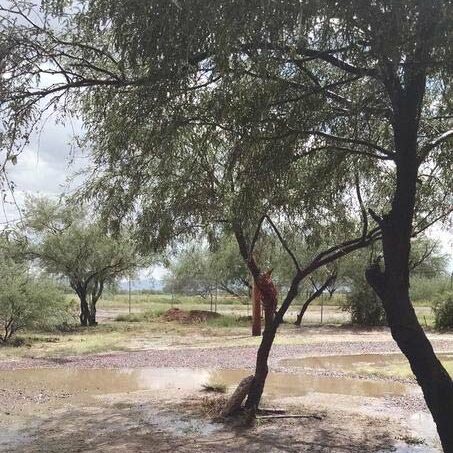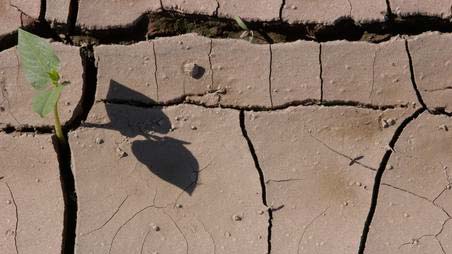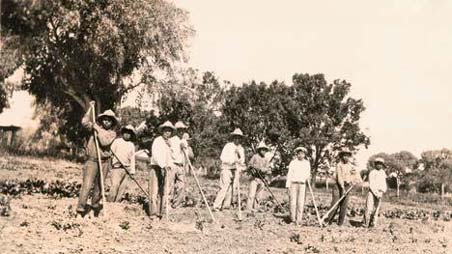About
Our Mission
The San Xavier Cooperative Association is committed to healthy farming practices and growing traditional crops to support the cultural and environmental values, as well as support economic development within the community.
The San Xavier Cooperative Farm considers the following aspects (and others) of the Tohono O’odham Himdag, or Way of Life, to ensure that decisions in the farm’s rehabilitation project are consistent with the culture.
Respect for Land
→ Improve health of land each year through wise use of available resources, including CAP water.
→ Use existing topographical characteristics of land in determining designs and water systems.
→ Analyze results of soil tests.
→ Avoid use of herbicides, pesticides, and other harmful substances.
Sacredness of Water
→ The Tohono O’odham culture teaches the younger generations that water is sacred, as the culture is built around the calling for, and celebration of, the coming of rain.
→ Harvest rainwater.
→ Dilute CAP water to avoid damage to soil.
→ Perform ceremonies of thanks for all water.
Respect for Elders
→ Serve as a venue for Elders to pass on traditional knowledge about farming and the Himdag.
→ Make traditional food crops available to help the community achieve a state of wellness.
→ Provide volunteers to help distribute seasonal harvests.
→ Create stronger ties throughout the community, especially between Elders and younger generations.
Respect for Animals
→ Acknowledge the usefulness of animals who pollinate crops, aerate the soil, and rejuvenate the mineral content of the land.
→ Develop a farm plan that includes attracting pollinators to assist with growing crops.
→ Include the assistance of underground animals and micro biotic organisms in the plan for the successful growing of crops.
→ Use a method of controlling “pests” that do not harm the beneficial animals.
Respect for Plants
→ Provide opportunities to enhance successful harvests with ceremonies throughout the growing season.
→ Grow crops that were developed by those “Who Have Gone Before.”
→ Grow crops, such as wild flowers and native plants, whose seed can be sold for use in rehabilitating the land.
→ Grow mesquite trees, which can provide food, be used for building purposes, as firewood, for the construction of furniture, and as material for artisans.
History
The story of the farm, as with all life, begins with water. The Santa Cruz River is the life blood of the people who settled in this valley thousands of years ago. Agriculture and working with the seasons of the river has been the way people have flourished here for so many generations.

The farm is on the Tohono O’odham Nation in the San Xavier District in the ancestral village of Wa:k.
Throughout time families farmed the land using an intricate canal system to irrigate fields and traded with other villages for staples such as salt. The Santa Cruz River, was the only place on the TO Nation where irrigation agriculture was possible.
In 1887 the United States Congress passed the General Allotment Act, which authorized the president to survey Indian tribal land and divide the area into allotments for individual Indians and families. The Allotment Act (also known as the Dawes Act) was applied to reservations whenever, in the president’s opinion, it was advantageous for particular Indian nations. Members of the selected tribe or reservation were either given permission to select pieces of land—usually around 40 to 160 acres in size – for themselves and their children, or the tracts were assigned by the agency superintendent. Around 69,000 acres of land in San Xavier were part of this Allotment Act with a total of 363 land owners. This fractionized the land and made the production of food up to individual families instead of growing food as a whole community.
Once surface flow along the Santa Cruz disappeared because of down cutting and groundwater pumping, O'odham agriculture in San Xavier became a thing of the past. In 1971 a group of Allottees in San Xavier got together and formed a cooperative of land owners in order to piece some of the lands back together and find a way to farm it as a whole.


In 1975 the Tohono O'odham pressured the federal government to file suit against agribusiness men, copper mines, and the city of Tucson, who were sucking water from the aquifer beneath the San Xavier District. In the end Congress passed the Southern Arizona Water Rights Settlement Act in 1982, granting 56,000 acre-feet of water a year to San Xavier through the Central Arizona Project (CAP). This allowed for the farm to be productive for the community again.
About the Logo
The logo for the San Xavier Co-op Farm was designed by Clifford Pablo, an allottee, one of the founders of the Cooperative and the first farm manager. The logo is a shield with a traditional planting stick and feathers for blessing. The central sprouting seed, "New Life" is surrounded by our native seed varieties of beans, corn, melon and squash. The four sections stand for the four directions and the four seasons which contain the cycles of the sun, rain, moon and wildlife. The birds and bugs are also symbols of destructive and helpful natural forces. The balance of all these elements is what brings success to the seeding and the farm.

Original design

Current design
Tour the Farm
If you'd like to have a tour of our farm, please fill out this form.
OR
